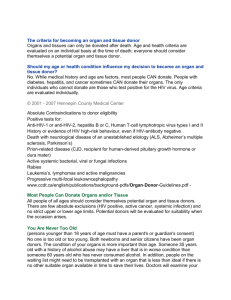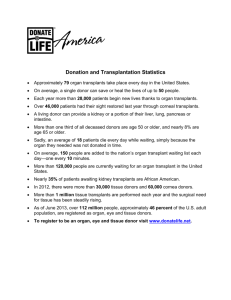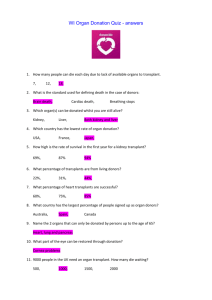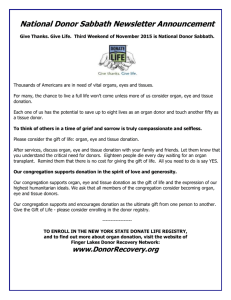Monroe`s Motivated Sequence Reading
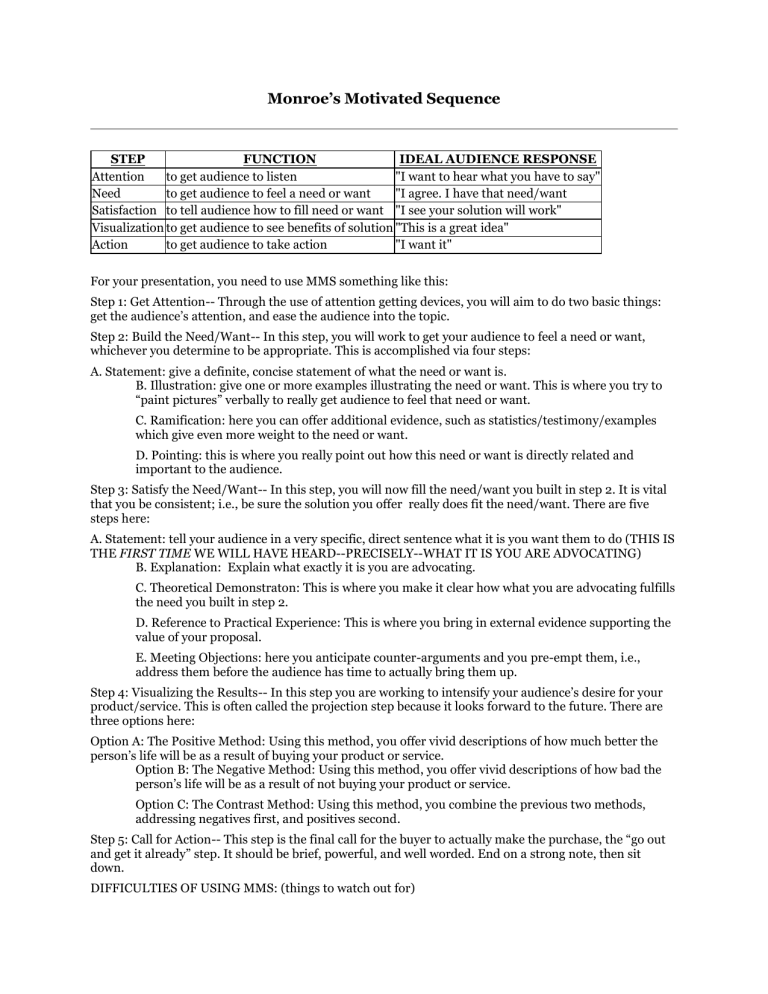
Monroe’s Motivated Sequence
STEP
Attention
FUNCTION to get audience to listen
IDEAL AUDIENCE RESPONSE
"I want to hear what you have to say"
Need to get audience to feel a need or want "I agree. I have that need/want
Satisfaction to tell audience how to fill need or want "I see your solution will work"
Visualization to get audience to see benefits of solution "This is a great idea"
Action to get audience to take action "I want it"
For your presentation, you need to use MMS something like this:
Step 1: Get Attention-- Through the use of attention getting devices, you will aim to do two basic things: get the audience’s attention, and ease the audience into the topic.
Step 2: Build the Need/Want-- In this step, you will work to get your audience to feel a need or want, whichever you determine to be appropriate. This is accomplished via four steps:
A. Statement: give a definite, concise statement of what the need or want is.
B. Illustration: give one or more examples illustrating the need or want. This is where you try to
“paint pictures” verbally to really get audience to feel that need or want.
C. Ramification: here you can offer additional evidence, such as statistics/testimony/examples which give even more weight to the need or want.
D. Pointing: this is where you really point out how this need or want is directly related and important to the audience.
Step 3: Satisfy the Need/Want-- In this step, you will now fill the need/want you built in step 2. It is vital that you be consistent; i.e., be sure the solution you offer really does fit the need/want. There are five steps here:
A. Statement: tell your audience in a very specific, direct sentence what it is you want them to do (THIS IS
THE FIRST TIME WE WILL HAVE HEARD--PRECISELY--WHAT IT IS YOU ARE ADVOCATING)
B. Explanation: Explain what exactly it is you are advocating.
C. Theoretical Demonstraton: This is where you make it clear how what you are advocating fulfills the need you built in step 2.
D. Reference to Practical Experience: This is where you bring in external evidence supporting the value of your proposal.
E. Meeting Objections: here you anticipate counter-arguments and you pre-empt them, i.e., address them before the audience has time to actually bring them up.
Step 4: Visualizing the Results-- In this step you are working to intensify your audience’s desire for your product/service. This is often called the projection step because it looks forward to the future. There are three options here:
Option A: The Positive Method: Using this method, you offer vivid descriptions of how much better the person’s life will be as a result of buying your product or service.
Option B: The Negative Method: Using this method, you offer vivid descriptions of how bad the person’s life will be as a result of not buying your product or service.
Option C: The Contrast Method: Using this method, you combine the previous two methods, addressing negatives first, and positives second.
Step 5: Call for Action-- This step is the final call for the buyer to actually make the purchase, the “go out and get it already” step. It should be brief, powerful, and well worded. End on a strong note, then sit down.
DIFFICULTIES OF USING MMS: (things to watch out for)
1. Careful of repetition. It is very easy to find yourself repeating points from one step in another step. For instance, the attention step should not get into need building. Or in step four, visualization, don’t repeat things from step 3.
2. Be sure to do all steps. Frequently I hear students start these speeches with “I’m here to get you to. . .”
Clearly, that is the statement from step 3. Be sure to use some sort of attention getting device and build the need/want first.
3. Be sure to take time to build the need. What I think happens is that dealing with the specific action is so straightforward that students want to jump to that. Granted, need/want building is less “definite,” but it is so vitally important.
4. Be sure to use clear “statements” at the beginning of the steps. This allows for clear transitions.
5. Be sure you need/want and action advocated are consistent. In other words, make sure your action has solvency. Solvency is when your proposal really does fill the need/want developed in step 2.
6. Make sure all proposals have workability. An advocated action is workable for an audience if they can reasonably do it--that the advantages outweigh the difficulties of doing it. Can they afford it? Do they have time? Are they able to do it?
Sample Speech
Topic: Organ Donation
Specific Purpose: To persuade my audience to donate their organs and tissues when they die and to act upon their decision to donate.
Thesis Statement: The need is constantly growing for organ donors and it is very simple to be an organ donor when you die.
I. INTRODUCTION
A. Attention material/Credibility Material: How do you feel when you have to wait for something you really, really want? What if it was something you couldn’t live without? Well, my cousin was five years old when he found out he needed a new kidney. He went on the organ waiting list right away. He was called twice during a six month span that they had a kidney available only to find out that the kidney wasn’t a good match. He had to wait again. The third time was a charm. A small adult was in an accident and his kidney was a good match. This story had a happy ending but so many do not.
B. Tie to the audience: One of the people on the waiting list for an organ transplant might be someone you know.
C. Thesis and Preview: Today I’d like to talk to you about first, the need for organ donors in our area, second, how you can become an organ donor after you die, and finally, how your family and organ donor recipients benefit from you donation.
[Transition into body of speech]: I’ll begin by telling you about the need for organ donors.
II. BODY
A. People around the world but also right here in Minnesota, Wisconsin, Iowa, and Illinois, need organ transplants and they need our help.
1. The problem is that there is a lack of organs and organ donors who make organ transplantation possible. a. The need is many organs and tissues such as the heart, lungs, liver, kidneys, pancreas, corneas, bone, skin, heart valves, and blood vessels(Iowa Statewide
Organ Procurement Organization undated brochure).
b. A new name is added to the national waiting list every 16 minutes. That means that 3 people will be added to the list during the time we are in class today.
1) The problem is that 10 people will die each day waiting for an organ transplant (LifeSource: Questions and Answers).
2) The reason is that are only on the average 5,000 donors nationally per year (LifeSource: Statistics). c. You can choose to donate any needed organs or you can specify which organs or tissues you wish to donate.
2.. Organ donation is very important. a. The following poem by Robert Test entitled, "To Remember Me," shows the importance of organ donation.
"Give my sight to the man who has never seen a sunrise, a baby’s face or love in the eyes of a woman. Give my heart to a person whose heart has caused nothing but endless days of pain… Take my bones, every muscle, every fiber and nerve in my body and find a way to make a crippled child walk…Take my cells, if necessary, and let them grow so that, someday, a speechless boy will shout at the crack of a bat and a deaf girl will hear the sound of rain against her window (South Dakota Lions Eye Bank, undated brochure). b. Not only is this a problem nationally but also it is a big problem right here at home in the Midwest.
1) Nationally, there are over 62,000 people waiting as of October 7,
1998. As of October 7, 1998, there are 1,422 people from Minnesota,
North Dakota, South Dakota, and part of Wisconsin that are on the organ waiting list (LifeSource: Statistics).
2) The sad part is that there have only been 104 donors in the Midwest so far from January 1998 through August 1998 (LifeSource: Newsnotes).
[Transition: I’m sure that you can see the need for people like you to donate your organs.
The majority of this class has already said they would like to donate their organs when they die. But you might be asking, well, how can I make sure my organs are donated after I die?
Let me tell you.]
B. This is how you go about making sure your organs are donated.
1. Talk with your family about your decision. They will be involved in the donation arrangements when you die. If they do not know your wishes of becoming a donor, your wishes may never be carried out.
2. Mark your driver’s license so that your license indicates your intent to donate. Each state varies. a. Fill out, sign and carry a uniform donor card with you. b. This donor card says what organs you wish to have donated and also has places for your family members to sign as witnesses after you have discussed your decision with them (Gundersen Lutheran
Hospital [LaCrosse, WI] undated brochure).
[Transition: You can see that it isn’t difficult to be an organ donor. Now let’s look at what may happen if you choose to donate your organs and what may happen if you choose not to.]
C. Organ donation benefits both the donor’s family and the recipients.
1. If you do donate your organs, your family and the people who receive your organs might benefit in a similar way like this family. A seventeen year old died of head injuries in a car accident. His mom decided to donate his organs. His heart went to a prison chaplain, his kidneys went to a mother of 5 children and a
Vietnam vet. The Vietnam vet is "energetic" and finally is getting his college degree. The teenager gave life to others and his family feels a sense of satisfaction and comfort that other lives have been touched by his
(University of Wisconsin Hospital and Clinics 1991 brochure).
2. The problem arises when you are thinking about becoming a donor but never do anything about it.
Then, no one knows your wishes and your organs will not be donated. The consequences of this are more people waiting for organs and there will still be an incredible shortage of available organs.
III. CONCLUSION:
A. Brakelight/Transition: As you can easily see, donating your organs can be one of the most important decisions you ever make and also the greatest gift you could ever give.
B. Summary: I’ve told you about the need for organ donors in our area, how you can become an organ donor after you die, and finally, how your family and organ recipients benefit from your donation. You become a donor by talking to your family and making sure they know you want to be a donor, fill out and sign a donor card, and indicate your wishes on your driver’s license.
C. Tie Back to the Audience: What if the person waiting on the list needing an organ transplant was someone you loved? Imagine if you had a brother or sister who had unexpectedly died and you were able to meet the person who received their heart, for example. Think of the satisfaction and possible comfort knowing that your brother or sister provided life for somebody else.
D. Concluding Remarks: I’m going to leave you with a short message from Michael Jordan who is a sponsor for the Iowa LifeGift Coalition on Organ and Tissue Donor Awareness and appears in their 1996 brochure. "Please make the decision to become an organ and tissue donor. Remember: Share your life.
Share your decision."
WORKS CITED
Gundersen Lutheran Hospital (Lacrosse, WI): "Life…Pass It On." Undated brochure. Iowa LifeGift Coalition on Organ and Tissue
Donor Awareness: "Share Your Life, Share
Your Decision." 1996 brochure. Iowa Statewide Organ Procurement Organization: "Be an organ donor…it’s the chance of a lifetime!" undated brochure.
LifeSource:Newsnotes. October 1998. Accessed November 2, 1998. < www.life-source.org/newsnotes.htm
>.
LifeSource: Questions and Answers. April 1998. Accessed November 2, 1998. < www.life-source.org/public.htm
>.
LifeSource: Statistics. October 1998. Accessed November 2, 1998. < www.life-source.org/statistics.htm
>.
South Dakota Lions Eye Bank: "No Greater Gift…Than Yourself To Others." Undated brochure.
University of Wisconsin Hospital and Clinics: "A Circle of Life: The Gift of Organ and Tissue Donation." 1991 brochure.

